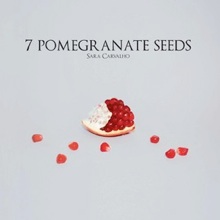
“Seven Pomegranate Seeds, in-between gestures and Timbre”
TIAGO CABRITA

Sara Carvalho (1970) has published, under the Numérica label, a CD with her works entitled “Seven Pomegranate Seeds”. Contrary to what the title may perhaps suggest, “Seven Pomegranate Seeds” does not consist of seven parts or movements. These pieces are actually seven different works – and, indeed, from relatively distinct periods. For example, “Blows Hot and Cold”, for string quartet, dates back to 1996 and it was later revised in 1997. Other illustrations are provided by “Solos IV”, for soprano (2000), as well as other more recent pieces, written between 2006 and 2009.
In terms of the structure, the album combines ensemble and solo works.
Generally, Sara Carvalho’s music explores the timbre in a quite interesting way. On the one hand, the timbre variation is perhaps more varied in the solo instrument pieces. “The Moon Lost Her Name” should be highlighted here, insofar as it displays a discourse, which successfully integrates the coexistence of various sound textures (such as artificial overtones, articulations and diverse strikes of the bow on the strings, like the jeté) and a “melody” that (if it really does exist) emerges from the noise fragmented. On the other hand, the pieces for ensemble seem to be even richer in what concerns working with timbre (assuming now the term “timbre” as “sound”).
“Solos IV”, for soprano solo, is divided in three scenes. The piece is based on the myth of Persephone, who is kidnapped by her uncle Hades, causing a great suffering to her mother, Ceres. The composer emphasises the existence of visual elements, which help the listener to understand the existence of the three different characters (Persephone, Ceres and the narrator). Unfortunately, in the case of this piece, the music does not dispense with the visual motives, to which the composer relates. In fact, no sufficiently contrasting musical discourse for the listener to clearly perceive the formal transition does seem to exist, especially between the first and the second scene. However, on stage such a transition must certainly be more evident. It is noteworthy, nevertheless, that this does not happen in the passage from the second to the third scene. There, the voice significantly expands the timbre variation as well as the musical material itself, articulating the singing with speech, whispering, etc.
“Postlude, Still in Fugue” is, as Sara Carvalho explains, the modern version of her piece “Prelude in Fugue”, written for pianoforte. It is a piece in whose development the tremolo figure gains a significant predominance. There appears to be a melodic contour, which is being changed in an apparently improvisatory manner. If there is a moment, on this CD, in which melody and lyricism take hold of the music, conducting and conditioning the harmony in a quite dynamic manner, it is surely “Postlude, Still in Fugue”.
Sara Carvalho’s music gains new qualities when it passes to the domain of chamber / ensemble music. “Cleave II”, the first piece of the CD, is extremely well achieved, impressing at once with a particularly rich and interesting sound composition. In the initial section, the ensemble is treated as a kind of resonance chamber, being launched by the instrument(s) with a more melodic function – or at least, with a certain predominance in the musical discourse, from the listener’s point of view. In a certain way, this preoccupation makes references to the problems of the spectral school, in which one can distinguish composers such as Gérard Grisey, Tristan Murail and Jonathan Harvey (or more recent inheritors of this type of approach, Kaija Saariaho or Marc-André Dalbavie).
The first section of “Motion Machines II” has a gloomier atmosphere. The piece’s second part, lengthier than the first one, uses a counterpoint and clear opposition between the instruments. The interventions of each instrument are stressed rhythmically, both by the piano and accordion, thus creating a rhythmical unpredictability, which is very welcome and efficient as a musical discourse.
Another piece, “Hollow”, displays a special atmosphere. The piano (with a particularly interesting exploration of the timbre – produced directly inside the instrument, for example) and the percussion form a background against which a dialogue between the clarinet and flute is being developed between light melodic contours and tremolos. There are moments in which the roles are inverted (different pairs are established) and in others the ensemble seem to function as one block. Still, the discourse, even though rich, seems to, at times, lack a certain definition / direction, given that it is not easy to perceive that a clearly defined path is being taken up to a determined arrival point.
“Blows Hot & Cold” is a piece for string quartet from 1997 which is divided in two movements. The first one, with more vigorous gestures than the second one, in spite of obvious differences reminds us of, quartets of two composers from the first half of the 20th century (Leoš Janáček and Bela Bartók), who somehow seem to have marked the way of writing for this formation.
Besides emphasising the excellence of the performers and the interpretations of the pieces on the CD (and one could not fail to mention the subtlety of the interpretation by Raquel Camarinha and of all the involved ensembles, without any exception), it is worth noting the undeniable quality of Sara Carvalho’s music. It is loaded – in the word’s positive sense – with sensibility, colour and profundity.
This CD contains more than sufficient richness so that, with every new audition, one experiences a kind of rediscovery and renewed interest.


